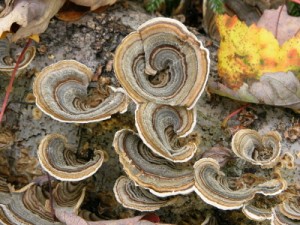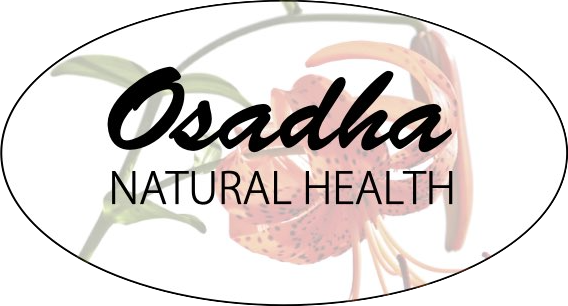 Most people in the US probably have never heard of Turkey Tails, a mushroom that is widespread here and throughout the world. Those who spend time in the woods have likely seen them, even if they didn’t know what the beautiful, striped mushrooms were. The botanical name of the mushroom is Trametes versicolor, and it is also known as Coriolus versicolor. The Turkey Tail fruiting body — the visible part of the mushroom — looks like it’s name. It’s thin and fan-shaped with different colored stripes or striations. The colors are quite variable, including orange, brown, grey, white and even blue. The striped upper surface may be somewhat hairy. The underside has pores rather than gills and is white when the fruiting body is fresh. In California, where I first learned about Turkey Tails, there are two lookalikes. One has gills rather than pores and is easy to distinguish. The other, of the genus Stereum, is smooth underneath (no gills) but the underside is yellow and not as regularly pored as are Turkey Tails. Both this latter one and Turkey Tails grow here in Colorado (1). As Turkey Tails age, the underside becomes tan or yellowish, so it becomes a bit trickier to distinguish it from Sterenum species, but once you get to know Turkey Tails, it becomes obvious which is which. It’s also good to know that neither of lookalikes are poisonous.
Most people in the US probably have never heard of Turkey Tails, a mushroom that is widespread here and throughout the world. Those who spend time in the woods have likely seen them, even if they didn’t know what the beautiful, striped mushrooms were. The botanical name of the mushroom is Trametes versicolor, and it is also known as Coriolus versicolor. The Turkey Tail fruiting body — the visible part of the mushroom — looks like it’s name. It’s thin and fan-shaped with different colored stripes or striations. The colors are quite variable, including orange, brown, grey, white and even blue. The striped upper surface may be somewhat hairy. The underside has pores rather than gills and is white when the fruiting body is fresh. In California, where I first learned about Turkey Tails, there are two lookalikes. One has gills rather than pores and is easy to distinguish. The other, of the genus Stereum, is smooth underneath (no gills) but the underside is yellow and not as regularly pored as are Turkey Tails. Both this latter one and Turkey Tails grow here in Colorado (1). As Turkey Tails age, the underside becomes tan or yellowish, so it becomes a bit trickier to distinguish it from Sterenum species, but once you get to know Turkey Tails, it becomes obvious which is which. It’s also good to know that neither of lookalikes are poisonous.
Turkey Tails are saprophytic; they grow on dead and decaying hardwoods and, sometimes, coniferous trees. In the right conditions, dead trees and downed logs may be covered with them. The fruiting bodies are so plentiful and fast-growing that harvesting them is not a problem. An herbalist and teacher of a medicinal mushroom class I attended said that her porch was slowly being devoured by Turkey Tails. It’s a convenient Turkey Tail source, but the porch may someday disappear. The fruiting bodies are edible, but chewy. Author and mushroom expert David Arora said in reference to their edibility: “Boil for 62 hours, squeeze thoroughly, and serve forth” (2). They have many beneficial constituents that are water-soluble, so they are a great addition to broths, soups and stews, though I would pull them out before serving.
Turkey Tails have been used as medicine and food for centuries in Asia. In China, they are known as Yun Zhi, or “Cloud Mushroom”, and it makes me wonder if the swirly mushroom clouds seen in Asian art aren’t in fact Turkey Tails (see my article on Reishi). In Traditional Chinese Medicine, they are used for enhanced immunity, to reduce phlegm, to dispel heat and to support the shen (again, see my article on Reishi) and to support digestion (3). Turkey Tails are popular for respiratory issues and for management of chronic illnesses (3). During the Ming Dynasty (16th century), the famous Chinese physician and pharmacologist Li Shizhen wrote about Turkey Tails in his Compendium of Materia Medica. Closer to home, Turkey Tails are part of the Mexican folk medicine tradition, and are used for skin infections (3).
The mushroom benefits many body systems, but have particular affinity for the lungs, liver and immune system. Turkey Tails are a lung tonic, and as discussed below, several different extracts of the mushroom are used as part of the treatment regimen for lung cancer. Turkey Tails are used in China for hepatitis and to support liver function (3). Turkey Tails have multiple effects on the immune system. They strengthen immunity, but are also immunomodulating. That is, they promote a balanced immune response. For example, Turkey Tails will build up a weakened immune system, for instance, in someone undergoing chemotherapy or radiation treatment. However, the mushroom will also reduce hyperactive or inappropriate immune responses, such as in autoimmune disorders. Indeed, there is some evidence that a Turkey Tail extract known as PSK (see below) reduces reactivity in a number of autoimmune diseases (3).
The activities of Turkey Tails are not restricted to those noted above. Turkey Tails have effects on cardiovascular function and cholesterol levels. Moreover, they exhibit broad spectrum antimicrobial activity. Microbes they inhibit include E. coli, Listeria monocytogenes, and Candida (4). Turkey Tails have strong antiviral activity and useful for upper respiratory infections and may suppress Herpes outbreaks (5). The mushroom may have activity against Hepatitis C Virus (6) and appears to inhibit various stages of HIV infection and replication (7-9).
Turkey Tails are one of the more heavily researched mushrooms, especially in relation to cancer. In fact, a component of Turkey Tails called polysaccharide Kureha (PSK) has been a common part of cancer treatment in Japan for several decades. PSK, a biological response modifier, suppresses tumor growth, prolongs life span and improves quality of life (10-12). PSK has shown beneficial results in the treatment of gastric, colorectal, breast and lung cancers (3, 4, 12). For instance, a clinical trial on breast cancer showed that postoperative treatment with PSK alone prolonged survival as long as postoperative treatment with a standard reagent, 5-fluorouracil. However, the side effects of long term PSK use are minimal, especially when compared to that of 5-fluorouracil. In various studies, PSK demonstrated tumoricidal effects, immunomodulatory effects, and suppression both initiation and metastasis of cancers (3, 4 10, 12).
Polysaccharopeptide (PSP) is another biological response modifier from Turkey Tails that has multiple effects on the immune system. It is used as adjunct cancer treatment and multiple clinical trials have demonstrated that PSP improves disease-free and overall survival rates following conventional treatment for a variety of cancers (11,12). A cell culture study suggested that PSP may potentiate the killing effects of chemotherapeutic drugs on cancer cells (13), though it is difficult to extrapolate this type of data to situation in a person. PSP may have utility in advanced, terminal stages of cancer as well. For instance, a clinical study suggested that PSP can slow the progression of advanced non-small cell lung cancer (14).
Most of the studies on Turkey Tails are with PSK and PSP that have been purified from a couple of cultured lab strains of the mushroom mycelia (the part you usually don’t see because it’s inside the log in nature). However, both the fruiting body and the mycelia have comparable antitumor activity (9). Large doses of Turkey Tail extract or powder are taken daily as a cancer preventative and general tonic (3, 5). This may be useful for those with a familial history of cancer (5), though these folks should be regularly screened as well. Also, PSK and PSP are available for purchase. However, you can easily make a Turkey Tail tonic yourself, by gathering them, freezing them to kill any bugs, then drying them. It’s important to note here that you should not try to use Turkey Tails to treat yourself if you have cancer. Supplementation on your own is fine, but seeking professional care is the way to go for dealing with such a serious disease.
In addition to a multitude of health-related uses, Turkey tails have been widely investigated for use in numerous industrial and environmental applications. For instance Turkey Tails have been researched for use in producing things such as brown paper bags, where the mushroom is used in wood pulp processing (15-16). At the other end of this equation, Turkey Tails have been investigated for use in cleaning up the effluent from pulp and paper mills (17, 18), and for bioremediation of PCBs, polycyclic aromatic hydrocarbons, industrial dyes, xenoestrogens and other environmental toxins (19-23).
Aside from being pretty to look at, Turkey Tails are pretty darn useful.
References
1. Evenson, VS (1997) Mushrooms of Colorado & the Southern Rocky Mountains. Denver Botanical Gardens & Westcliffe Publishers.
2. Arora, D. (1986) Mushrooms Demystified. Ten Speed Press, Berkeley, CA.
3. Hobbs, C. (1986) Medicinal Mushrooms: An Exploration of Tradition, Healing &
Culture. Botanica Press, Summertown, TN.
4. Stamets, P (2002) MycoMedicinals: A Informational Treatise on Mushrooms. Fungi
Perfecti, Olympia, WA.
5. Jenson, T, and K Aguilar (2008) Medicinal Mushrooms Class, California School of Herbal Studies, Forestville, CA.
6. Stamets, P. (2000) Growing Gourmet and Medicinal Mushrooms, 3rd Edition. Ten Speed Press, Berkeley, CA.
7. Collins, RA and TB Ng (1997) Life Sciences. 60: PL383-7.
8. Wang, HX, and TB Ng (2001) Planta Med. 67: 669-72.
9. Sakagami H and M Takeda (1993) Proceedings of the 1st International Conference on Mushroom Biology and Mushroom Products. World Society for Mushroom Biology and Mushroom Products. pp 237-45.
10. MD Anderson Cancer Center. Detailed Scientific Review. Coriolus versicolor <www.mdanderson.org/education-and-research/resources-for-professionals/clinical-tools-and-resources/cimer/therapies/herbal-plant-biologic-therapies/coriolus-versicolor-scientific.html>
11. Kidd, PM (2000) Alternative Medicine Reviews. 5: 4-27.
12. Standish, LJ, et al (2008) J Soc Integr Oncol. 6: 122-8.
13. Wan, J, et al (2010) Chinese Medicine. 5.
14. Tsang, KW, et al (2003) Respiratory Medicine. 97: 681-24.
15. Paice, MG et al (1993) Applied Environmental Biology. 59: 260-5.
16. Archibald, FS (1992) Applied Environmental Biology. 58: 3101-9.
17. Ortega-Clemente A, et al (2007) Biotechnol Bioeng. 96: 640-50.
18. Freitas AD, et al (2009) Sci Total Environ. 407: 3282-9.
19. Hoff, T et al (1985) Applied and Environmental Microbiology. 49: 1040-5.
20. Sack, U, and T Gunther (1993) Journal of Basic Microbiology. 33: 269-77.
21. Field JA, et al (1992) Applied and Environmental Microbiology. 58: 2219-26.
22. Auriol M et al (2008) Chemosphere. 70: 445-52.
~~~
Content © Dr. Anna Marija Helt, Osadha Natural Health, LLC. Permission to republish any of the articles or videos in full or in part online or in print must be granted by the author in writing.
The articles and videos on this website for educational purposes only & have not been evaluated by the Food and Drug Administration. This information is not intended to diagnose, treat, cure, or prevent any disease or to substitute for advice from a licensed healthcare provider.
